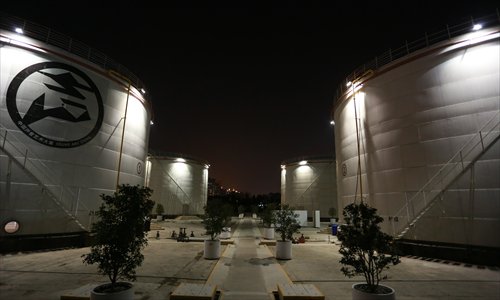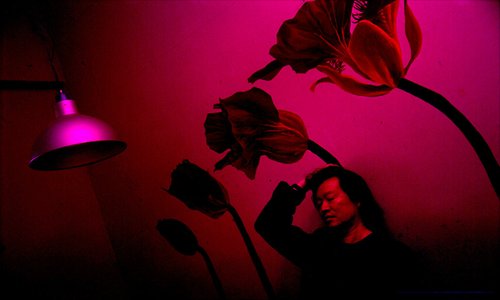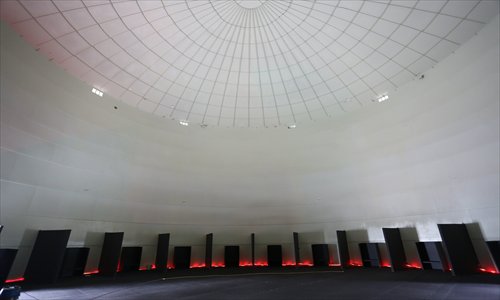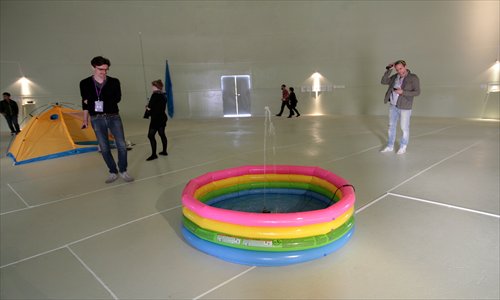Revolutions per minute

Four huge, deserted oil tanks are hosting China's largest-ever sound art exhibition
Early this year, Taiwanese sound artist Yao Da-juin climbed into one of four huge, deserted oil tanks standing upright at 2350 Longteng Avenue in Xuhui district to assess whether the site could be used to host China's largest-ever sound art exhibition.
"After measuring a 12-second long reverberation time and hearing how messy the sound was," Yao recalled to the Global Times, "I felt they were almost unusable for what I wanted to do."
However, Yao recognized the potential of the venue and inside these four giant cylinders mottled with rust, RPM: Sound Art China is currently being held. Yao is the curator.

Yao Da-juin
Carpeting and space dividers helped Yao to improve the acoustics. "They were used to break up the sustaining reverberation inside the oil tanks," he said.
A typical example is tank No.3, the venue of Yao's solo sound art piece, Tank Listening Shanghai. Utilizing the circular structure of the oil tank, plastic boards around the edges create small listening booths, like a round clock marked with 12 time points.
In fact the design was based on 18th-century English philosopher Jeremy Bentham's Panopticon surveillance prison structure.
Visitors sit in one of the booths and don a pair of headphones to hear a presentation of various everyday sounds that Yao recorded, including traffic sounds, as well as the local dialects spoken in Shanghai, Beijing and Taipei. Yang cites the Chinese language - "a remarkably rich system of communication" - as an enduring source of inspiration.
The first comprehensive survey of Chinese sound art ever held, RPM: Sound Art China brings together 36 sound works that range from circuit-bending, software programming, phonography and interactive installations, as well as live performances, audio releases and an international roundtable forum about sound art.
RPM, short for revolutions per minute, refers not only to the speed at which a record turns, but also hints at the incredible pace of development in Chinese sound art over the past decade.

Tank Listening Shanghai
Yao hopes to present the diversity and vitality of sound practices that are currently happening in the Chinese mainland, Hong Kong and Taiwan.
"Sound Art China is the best we can do to make these auditory efforts and achievements available to people all over the world who care," Yao said.
Housed inside tank No.4 is Hong Kong sound artist Samson Young's work, Chamber Music. Young, who was trained in music composition, has installed in the tank multiple noise-producing sources like a fan blowing a plastic bag, small objects with speakers embedded inside and a water fountain. And since these sound sources are all networked wirelessly, their synchronized movements of sound are mapped to the conversational phrasing structure of the first movement from Beethoven's String Quartet No.12. Op.127. The sounds are deliberately weak, resulting in a sea of networked murmur that is abstracted and distorted by the resonance of this vast space. Therefore, the visitor only can get a relatively clear sound when he or she puts an ear near to the sound sources.
Also in the tank are several fluorescent acrylic boards standing along the wall, inscribed with notes and meditative phrases that may help a visitor understand the work, which Yao describes as "poetic, whimsical and yet philosophical."

Chamber Music Photos: Courtesy of exhibition organizers
Inside tank No.2 is Jiang Zhuyun's Sound Medicine Chest. Several years ago, Jiang purchased an abandoned medicine chest from a Chinese herbal pharmacy. Visitors can open a drawer to listen to the sound inside, or open several drawers at the same time to listen a mixture of different sounds.
"The chest is really not made for looking at. It is not a regular installation or sculpture. It is almost an instrument, to be played," Yao said.
Yao explained the appeal of sound art as "the fact that music and sound are not visible, and they cannot be reduced to textual description, or explained through logical reasoning. To me, this is the single most exciting character of music and sound. It is emotions, sensitivity, and bodily resonance. They appear to be nonexistent and beyond this world, yet they are in fact utterly physical and experiential."
Yao acknowledged that some works are abstract and may be hard to understand, but added that "sometimes it really is not necessary to 'understand' works of art but just to experience them."
"Compared to most of contemporary art, sounds are not spectacles and they cannot be reduced to concepts or words," Yao added. "They need to be experienced."
RPM: Sound Art China is part of the ongoing West Bund Architecture and Contemporary Art Biennale 2013, which runs until December 19. In addition to the sound exhibition, there are also exhibitions of architecture and contemporary art.